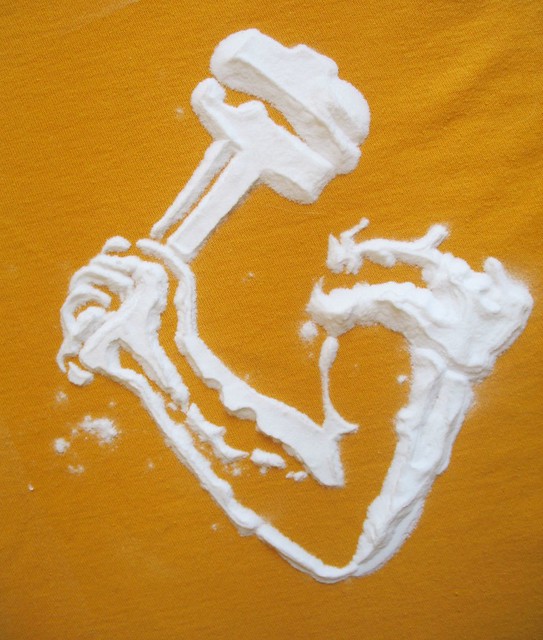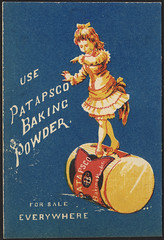
Despite having spent many years eating I still have much to learn about cooking. For example, I did not know there was any particular technique needed to fry an egg. When my husband walked my oldest son through the steps of egg frying, it was a night full of revelations—and not just for the intended student. These are just a few of the tips I picked up: sprinkle salt from high above the pan so that you do not get a salt clump; push the oil around with the spatula; do not leave the spatula resting on the hot pan. (Ok, I sort of knew that last one.)
What I can do is read a recipe. I can measure things and follow directions, more or less. Yet I know I am often just skimming the surface, as I did when I memorized things like the times tables and mnemonics like sohcahtoa. The unknowable lies behind the ingredient list, but I am usually hungry enough that I do not really feel like getting to know the unknowable at the time.
I made muffins the other day, and this time, I must have made them on a full stomach because I noticed that the recipe called for baking soda, but not baking powder. I especially noticed this because I could not find the baking soda. The cans look very similar, but there seems to be an important difference—bad things can happen, I’ve heard, if you mix up the two. How bad? I don’t know. But I always carefully check the name of what the one I’m measuring to ward off this mysterious fate.
Yet I want to throw off the shackles of this curse! I am a grown woman! I should not be afraid of two small cans of white powder! So I had a fortifying glass of wine and took to the internet.
Baking soda, I learned, is a straightforward fellow. With just one ingredient—sodium bicarbonate—it reacts with the acids it comes into contact with. This can mean rising cookies or “lava”-spewing volcanoes.
Baking powder, on the other hand, is one of those kids who’s, you know, different. Different like an explosion that could happen at any moment. First, it has baking soda in it—no wonder I’m confused. But it also has an acid it. Sometimes it has two acids! You’d think this was the recipe for instant explosion, but no, BP sits quietly on the shelf. The first acid, monocalcium phosphate, turns on when it’s mixed into wet batter. The other acid, which is usually either sodium acid pyrophosphate or sodium aluminum sulfate, needs both a liquidy batter solution and heat to start to fizz out carbon dioxide.
This sounds complicated, but not as complicated as what people used to do before baking powder made its debut in 1846. Home cooks used to make their own pearlash, which involved combining ashes with water to make lye, and then boiling off the water.

And now to my real question: why would you use baking soda and not baking powder? Or the reverse? Or sometimes both? Luckily, Bon Appetit had my back. Since I am still getting to know this problematic pair, I’ll let their writer Claire Saffitz explain it: “…Recipes vary widely in acidity levels and very often you need both kinds of reactions to achieve the right overall balance of flavor and texture. When baking soda reacts with an acid, it neutralizes it and makes the batter more alkaline. This takes away the sour flavor that the acid lends, and sometimes you actually want a little tartness. If there is additional bicarbonate of soda leftover after a reaction, it gives the baked good an unpleasant soapy flavor. Not good, right? The amounts of acid and sodium bicarbonate in a recipe need to be in some sort of balance, and you need to achieve the right level of airiness. In most cases that means soda plus powder.”
I am suddenly more intimidated by these muffins than I was before I started. So I will continue to rely on my foolproof method—when in doubt, add as many chocolate chips as possible.
*
Images by Flickr user Rakka and the Boston Public Library under Creative Commons license, 5/8/19
Looking at my little can of Clabber Girl baking powder, the first ingredient is corn starch. It’s also labeled “double acting” but I don’t know what that means.
Hi Fred! I think the corn starch might be a buffer that prevents the acid/base reaction from happening too soon, and I think the double-acting part means that there are two reactions, one when the baking powder gets mixed in with liquid, and one when it’s heated up. But I wouldn’t trust me.
Cameron, if I remember correctly, you’re right on the second point. As partial evidence, try to find “single acting” baking powder. Obviously, it would be half the price of double acting :-). The cornstarch is there as a filler, and moisture absorbing agent. If you didn’t have the cornstarch, the baking powder would be a solid lump, and you’d have to scrape it out.